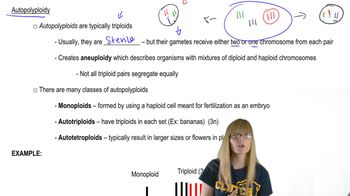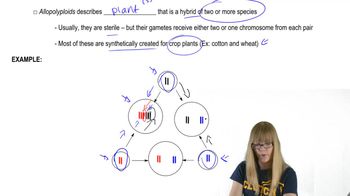Table of contents
- 1. Introduction to Genetics51m
- 2. Mendel's Laws of Inheritance3h 37m
- 3. Extensions to Mendelian Inheritance2h 41m
- 4. Genetic Mapping and Linkage2h 28m
- 5. Genetics of Bacteria and Viruses1h 21m
- 6. Chromosomal Variation1h 48m
- 7. DNA and Chromosome Structure56m
- 8. DNA Replication1h 10m
- 9. Mitosis and Meiosis1h 34m
- 10. Transcription1h 0m
- 11. Translation58m
- 12. Gene Regulation in Prokaryotes1h 19m
- 13. Gene Regulation in Eukaryotes44m
- 14. Genetic Control of Development44m
- 15. Genomes and Genomics1h 50m
- 16. Transposable Elements47m
- 17. Mutation, Repair, and Recombination1h 6m
- 18. Molecular Genetic Tools19m
- 19. Cancer Genetics29m
- 20. Quantitative Genetics1h 26m
- 21. Population Genetics50m
- 22. Evolutionary Genetics29m
6. Chromosomal Variation
Chromosomal Mutations: Aberrant Euploidy
Problem 11b
Textbook Question
The most common reason a physician might recommend that a woman have maternal serum screening and a karyotype analysis is concern that her fetus may have Down syndrome. Go to the OMIM website at www.ncbi.nlm.nih.gov/omim and look up Down syndrome (OMIM 190685).
How might those genes lead to the main symptoms of Down syndrome?
 Verified step by step guidance
Verified step by step guidance1
<span>Step 1: Understand the genetic basis of Down syndrome. Down syndrome, also known as Trisomy 21, is caused by the presence of an extra copy of chromosome 21. This results in three copies of chromosome 21 instead of the usual two.</span>
<span>Step 2: Identify the genes on chromosome 21. Chromosome 21 contains several genes, but some key genes associated with Down syndrome include APP, SOD1, and DYRK1A, among others.</span>
<span>Step 3: Explore how these genes contribute to symptoms. The overexpression of these genes due to the extra chromosome can disrupt normal development and function, leading to the characteristic symptoms of Down syndrome.</span>
<span>Step 4: Connect gene overexpression to symptoms. For example, the overexpression of DYRK1A is thought to contribute to intellectual disability and developmental delays, while APP is associated with early-onset Alzheimer's disease, which is more common in individuals with Down syndrome.</span>
<span>Step 5: Consider the broader impact of gene dosage imbalance. The presence of an extra chromosome affects the regulation of many genes, leading to a complex interplay of genetic and environmental factors that result in the diverse symptoms observed in Down syndrome.</span>
Recommended similar problem, with video answer:
 Verified Solution
Verified SolutionThis video solution was recommended by our tutors as helpful for the problem above
Video duration:
3mPlay a video:
Was this helpful?
Key Concepts
Here are the essential concepts you must grasp in order to answer the question correctly.
Chromosomal Abnormalities
Down syndrome, also known as Trisomy 21, is primarily caused by the presence of an extra copy of chromosome 21. This chromosomal abnormality results from nondisjunction during meiosis, where chromosomes fail to separate properly, leading to gametes with an abnormal number of chromosomes. When such a gamete contributes to fertilization, the resulting zygote has three copies of chromosome 21, which is the hallmark of Down syndrome.
Recommended video:
Guided course

Chromosome Structure
Gene Expression and Phenotype
The extra genetic material in Down syndrome affects gene expression, leading to the characteristic features and health issues associated with the condition. Genes on chromosome 21 are involved in various biological processes, and their overexpression can disrupt normal development. This dysregulation contributes to the physical traits, cognitive impairments, and increased risk of certain medical conditions seen in individuals with Down syndrome.
Recommended video:
Guided course

Penetrance and Expressivity
Maternal Serum Screening
Maternal serum screening is a prenatal test that measures specific substances in a pregnant woman's blood to assess the risk of certain genetic conditions, including Down syndrome. This screening typically occurs in the first or second trimester and can indicate whether further diagnostic testing, such as karyotype analysis, is warranted. It is a non-invasive method that helps inform expectant parents about potential genetic concerns.
Recommended video:
Guided course

Maternal Effect

 8:42m
8:42mWatch next
Master Aberrant Euploid with a bite sized video explanation from Kylia Goodner
Start learning



